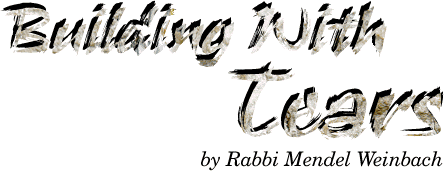Building with Tears

"Why are all these people sitting on the ground and crying?" This was a natural question for six-year old Chaim to ask his father on his first visit to the Western Wall — the Kotel — on Tisha B'Av.
"Well, my son, right next to the place we are standing there once stood the holiest building in the world, the Beit Hamikdash. This is where Jews served Hashem with sacrifices throughout the year, and here all Jews came at least three times a year. It was the most magnificent building ever seen. It stood on the mountain where our forefather Avraham brought his son Yitzchak and was prepared to offer him as a sacrifice to Hashem. Surrounding this Har Habayit (Temple Mount) were four walls. But because of our sins the Beit Hamikdash was destroyed on this day almost 2000 years ago, and all that is left of the walls around the mountain upon which it stood is this Kotel. Isn't that enough of a reason for Jews to cry?"
With the eternal optimism which is such a beautifully innocent part of childhood, Chaim looked up at his father, whose eyes too were filled with tears, and said:
"But Abba, don't we believe that Jerusalem and the Beit Hamikdash and the walls around it will someday be rebuilt? Look at it this way — one wall is already up, so we only need to put up three more!"
The concept of rebuilding Jerusalem and the Beit Hamikdash is not limited to the arrival of mashiach (messiah). That the Redeemer will merely complete the job which we have started is evident from our daily prayer for the rebuilding of Jerusalem. The prayer which begins with the plea for Hashem to "return His Divine Presence to Jerusalem and rebuild it, soon in our days, as an eternal structure" concludes with the words praising Hashem as the "One Who is building Jerusalem." The use of the present tense indicates that this construction is taking place right now, and leads the great biblical commentator Rabbi Moshe Sofer (Chatam Sofer) to present an interesting approach to understanding the meaning of this title:
"The Third Beit Hamikdash, which represents Jerusalem's ultimate building, will not be the product of human effort. The Midrash informs us that it will come down from Heaven as a finished product. This indicates that its construction is going on all the time. But what are the materials with which Hashem is building this sacred edifice? The answer is — our tears! The tears which are shed by Jews on Tisha B'Av and throughout the year are supernaturally transformed into the brick and mortar used by the Divine Builder Who now is Jerusalem."
Each generation in which the Beit Hamikdash is not rebuilt, say the Talmudic Sages, is considered as if it was guilty of its destruction. On the surface this seems like a pretty heavy indictment of so many generations of saintly Jews during the past two millennia who did not merit to see the Beit Hamikdash rebuilt. But if we apply the aforementioned concept of building with tears, the indictment is limited only to the generations who face the absence of a Beit Hamikdash with a sense of complacency, as if the destiny of the Jewish People is not dependent on this building coming down from Heaven.
This is the issue which has faced every generation since the destruction of the Beit Hamikdash on Tisha B'Av so long ago, and which faces our own generation. Do we realize how much is missing in our personal and national self-fulfillment because we lack this spiritual generator? And is this sense of unfulfilled spiritual potential profound enough to move us to tears?
Both Chaim and his father were right. We only have three more walls to build. But it is the tears in the eyes of his father and all the other Jews at the Kotel and throughout the world which are building those walls -- today.






